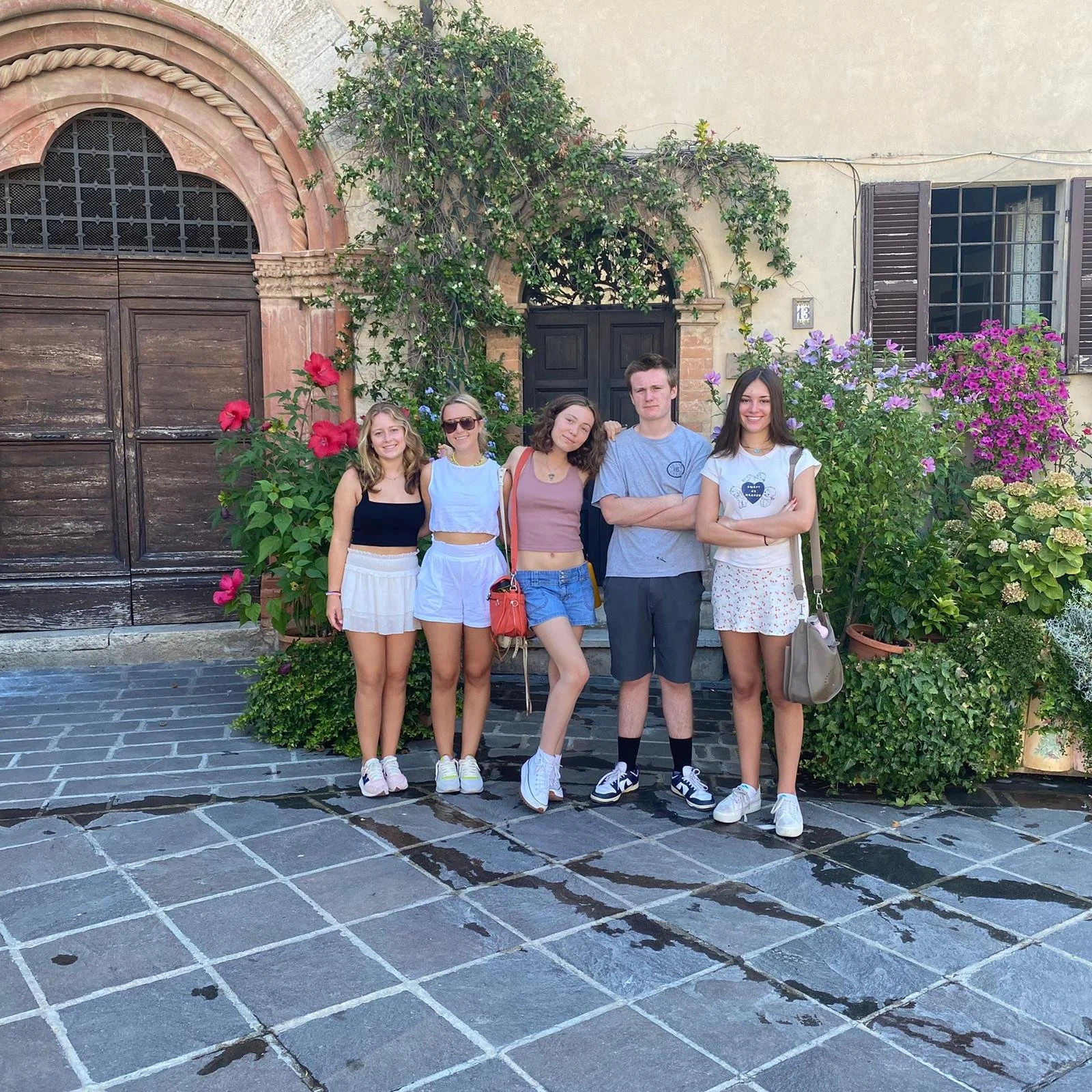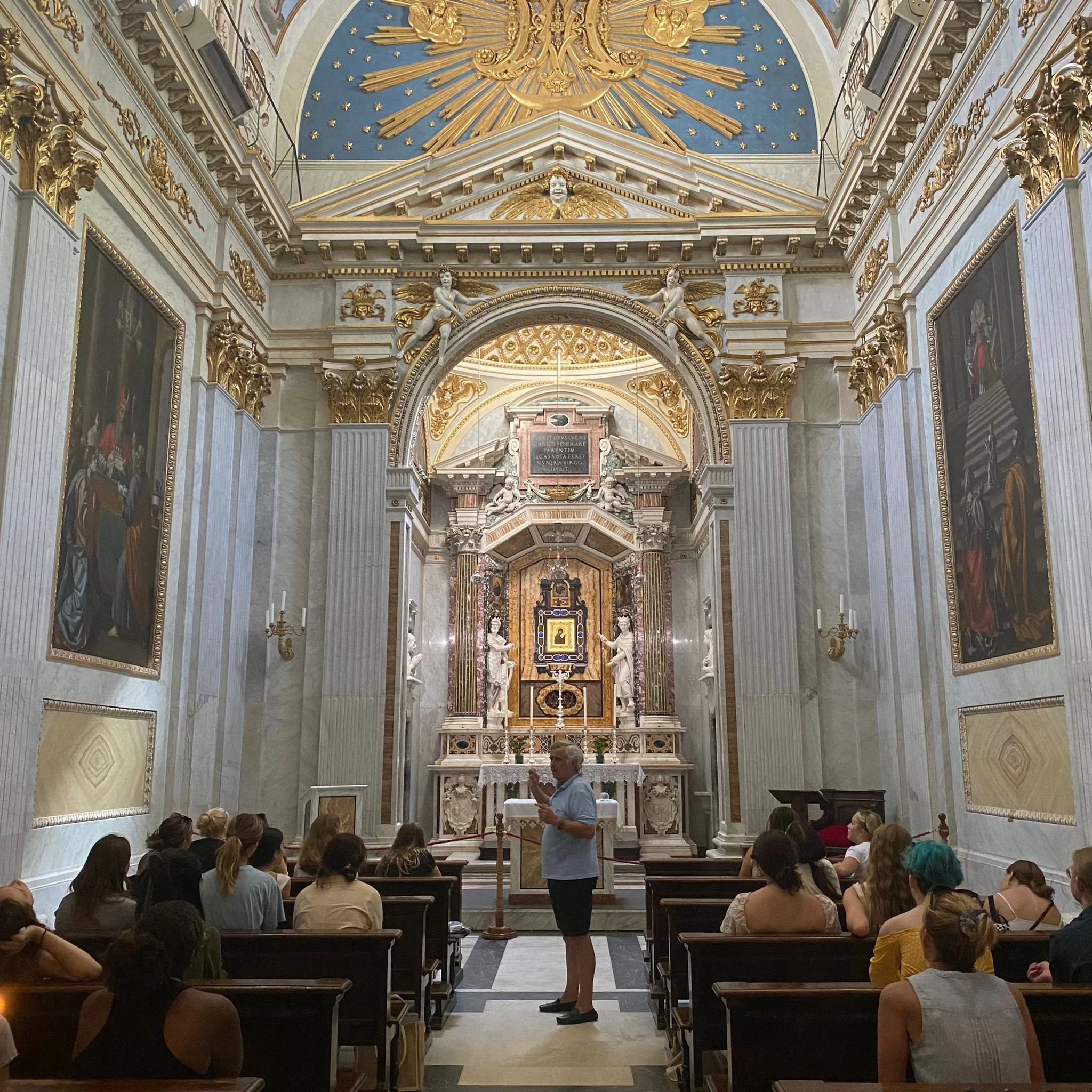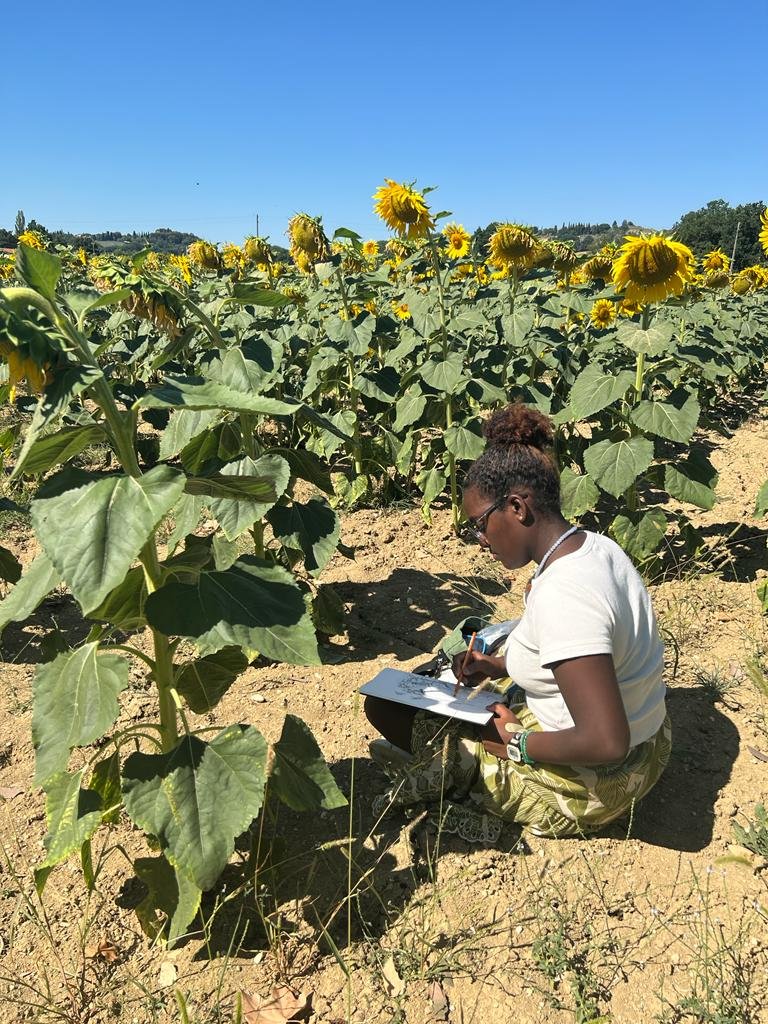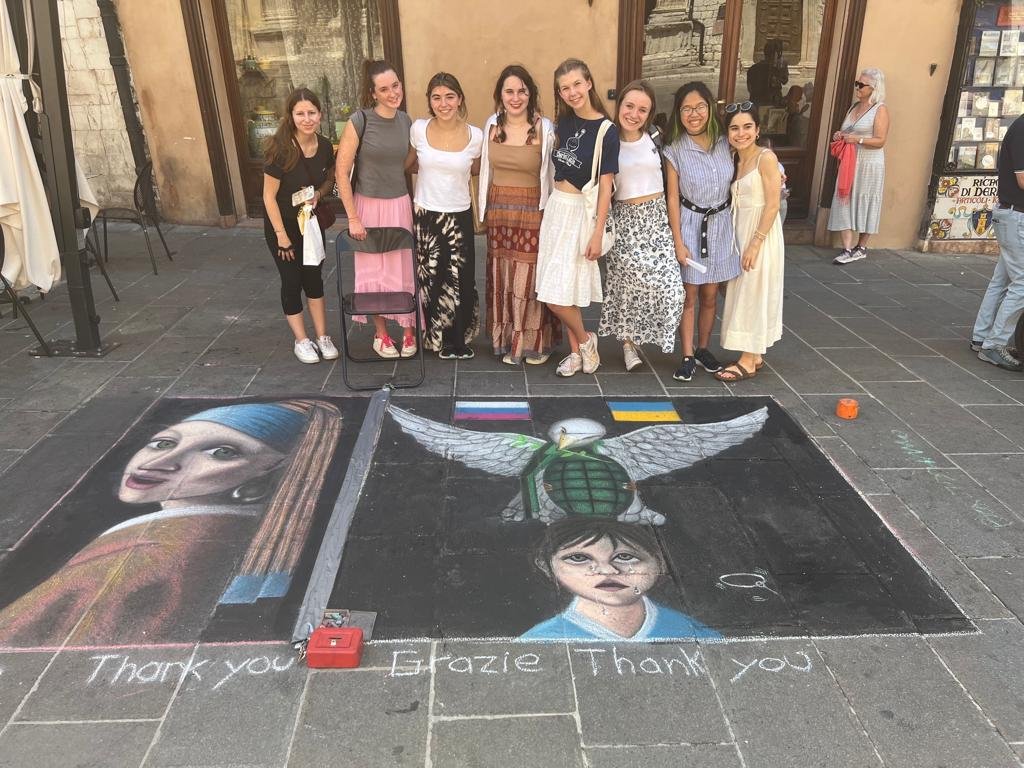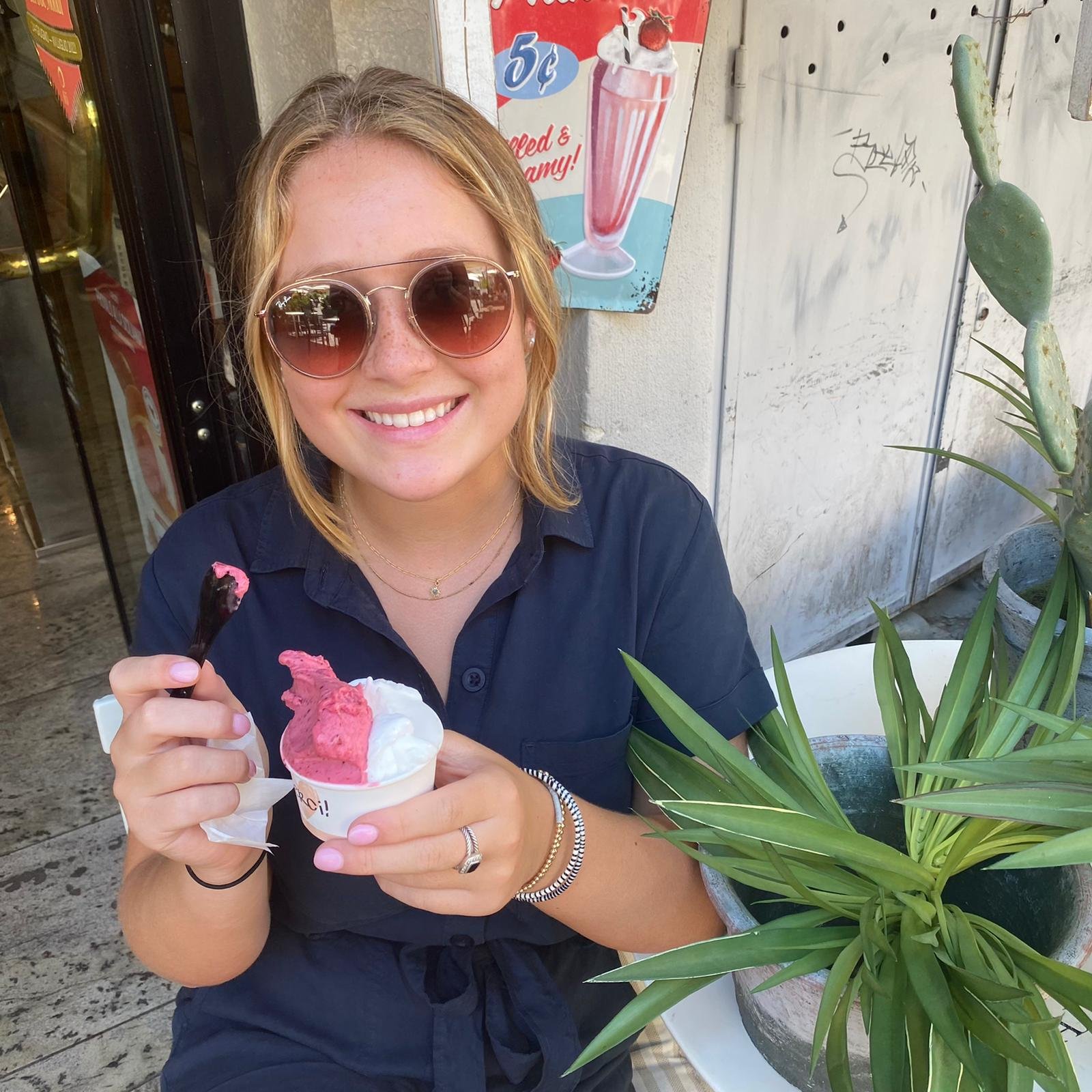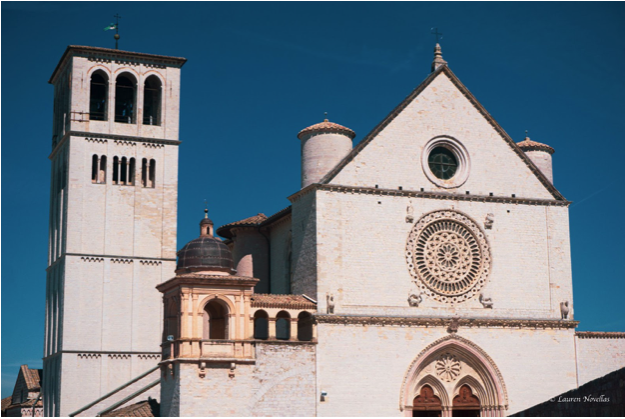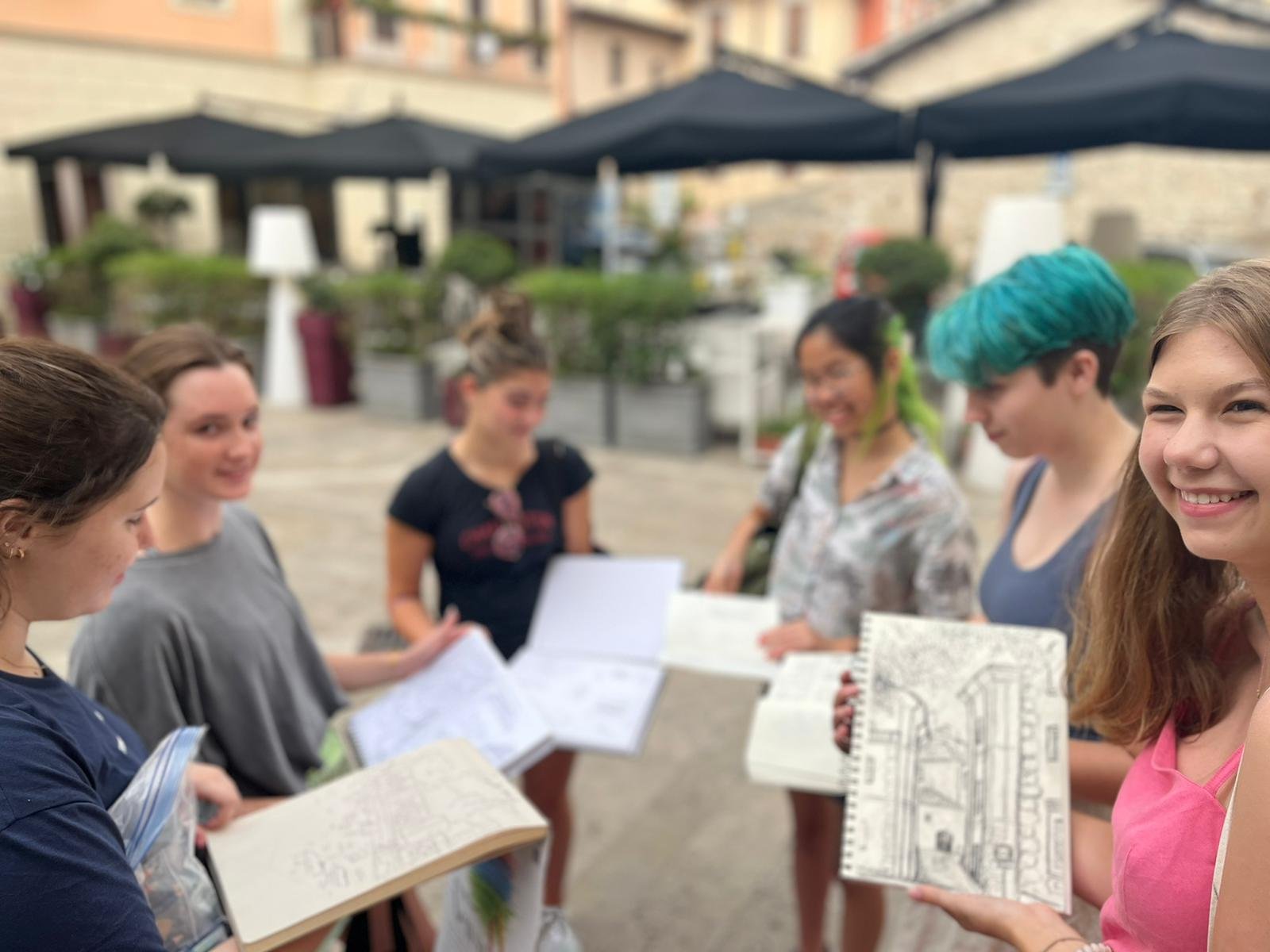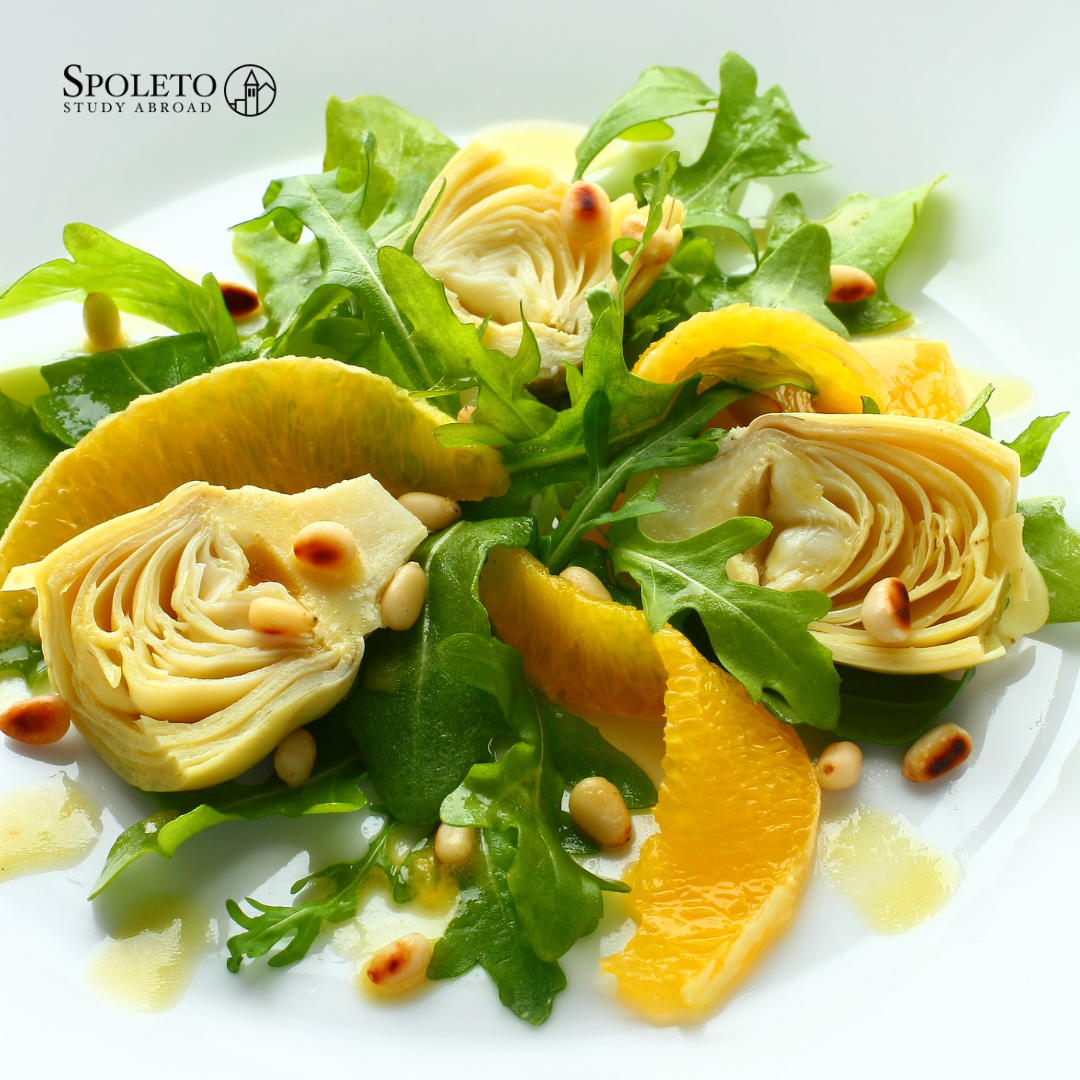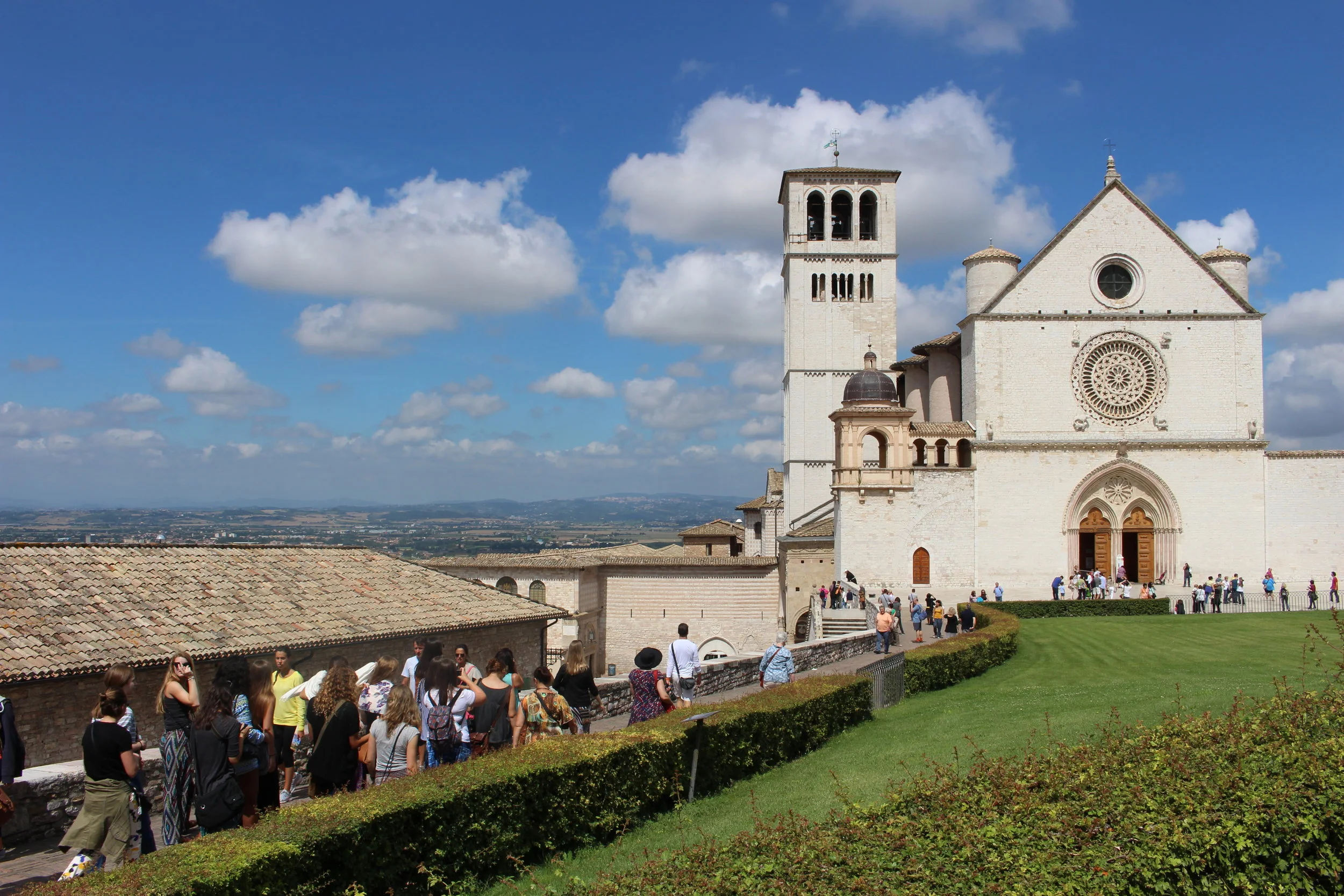
Day 9: The group’s final day in Spoleto
It’s hard to believe our Intensive program is coming to an end and it is our last day in Spoleto.
The Photography students finished up all of their editing in Adobe Lightroom and put together a final presentation of their artwork, and the visual arts students put the final touches on their pieces.
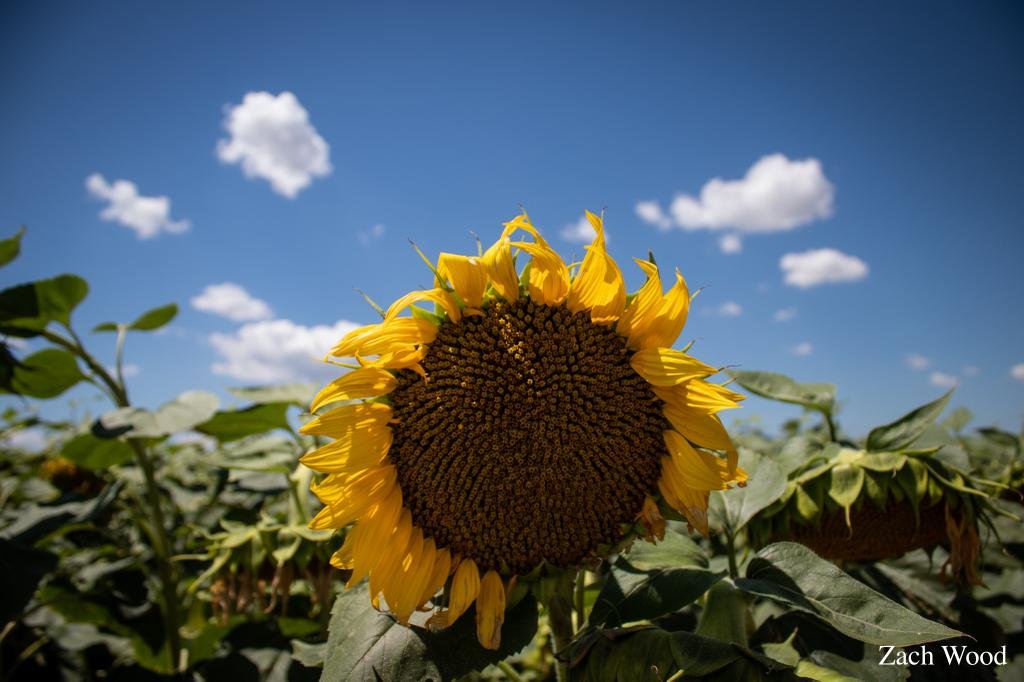


The final showcase highlighted and celebrated all of the hard work the students put in. It was heartening and inspiring to listen and to see the process by which each student reached his/her/their final pieces. Each artist provided an oral overview of inspiration, process, and product and celebrated the revision and editing time required to hone their respective skills. What a testament to our faculty and to the creative intentions of our artists. It was truly a privilege to spend this time with these budding forces!




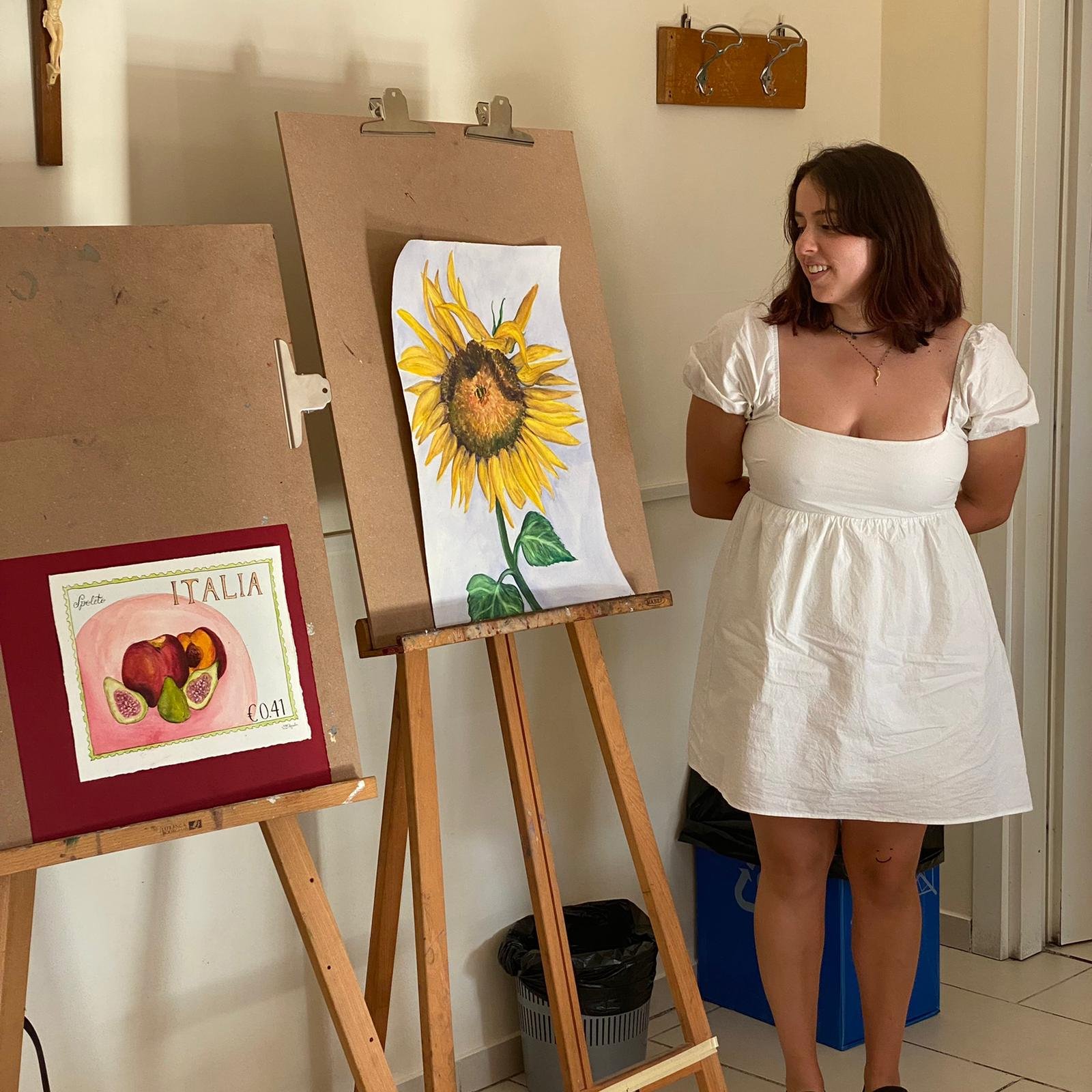

“During my time in Spoleto Italy, I not only grew as a photographer, but I also endured a beautiful, new social and cultural experience. This was my first time in Italy, so I had no real expectations as to what life would look like here. However, this magical city eclipsed any and every location I have traveled to. The beauty of Spoleto is genuinely unreal; its architecture, food, religion, values, and people all radiate a rich energy that is indescribable. In Spoleto, I had the opportunity to experience the city, form amazing relationships with the students from this program, and photograph heaps of images that I will hold onto forever.
As an artist, I typically gravitate towards capturing still photographs of people. Although the landscape and architecture of Spoleto is ethereal, the individuals who live here truly reflect Italian life. Because of this, I chose my portfolio to focus on the people of Spoleto. I explored Spoleto, Assisi, Spello, and Montefalco, and I captured many different people on my Canon Digital Camera. Each unique city led to more and more unique photographs. I am so grateful we got to travel across multiple cities because each had their own distinctive story to tell.
For my portfolio, I chose three of my favorite black and white photographs and three of my favorite colorful photographs. When editing in black and white, I chose to create a more timeless aura to the photograph to depict the timeless history of Italy. When editing in color, I chose to add a lot of saturation and vibrance in order to showcase the liveliness and color of Italy.
Although each set of photographs look very different, I truly believe that my time here has tremendously improved myself discovery as an artist by teaching me new techniques and giving me the agency to formulate my artistic aesthetic.
”
Day 8: Hello Montefalco!
Today, the photography students explored Montefalco, a beautiful village in Umbria. Situated in the central west of Umbria, Montefalco stands on a hill carpeted with olive trees and grape vines, in the middle of the valley of the Clitunno, Topino and Tiber rivers. This breathtaking position has led to Montefalco being known as The Balcony-rail of Umbria. Because of its environmental, cultural, and artistic heritage, Montefalco has become part of the club The Most Beautiful Villages of Italy.
A fresco in Montefalco
Meanwhile, Visual Arts students had studio time to finish their various pieces in preparation for tomorrow’s final showcase event.
In the evening, instead of having dinner at the Hotel Clitunno like usual, students dined in small groups with SSA faculty members at restaurants throughout Spoleto. It’s the penultimate day for our intensive students, and we can’t believe how time has flown!
Day 7: Touring Spoleto's Duomo
SSA students touring the duomo in Spoleto, led by Lorenzo Muti
Photography and art students began the day together with a tour of the Duomo di Spoleto led by Lorenzo Muti. The duomo was built in the 12th century, although like several other buildings in the area, it was built around an existing building. We learned that the lions, seen in sculptures near the duomo’s entrance, have symbolized the strength of the Catholic Church, and are common at Romanesque churches. The portico was built in the 15th century. It features Renaissance elements such as the harmonious interplay of geometric patterns in the floor tiles, and emblems including the bees symbolizing the importance of the Barberini family (one member being the Bishop of Spoleto, who later became Pope Urban VIII).
The entrance to Spoleto’s duomo, featuring lion sculptures
Upon entering the duomo, strains of soft organ music filled the air. The duomo is known as the Cathedral of Santa Maria Assunta (Cathedral of the Ascension of St. Mary), celebrating Mary’s life and ascent to heaven. This is depicted in a series of frescos by the artist Filippo Lippi entitled Stories of the Virgin (1466–1469). Mr. Muti explained how the artist used sketching and plaster techniques to produce the vivid images–and yet how some areas in which artists used dry-painting techniques on plaster added much later did not stand the test of time.
As an interesting side note, Filippo Lippi is also famous for having been a monk who fell in love with a nun and started a family. His self-portrait appears in the fresco above the choir loft. He is said to have continued to wear his monk robes for the rest of his life.
In the rear of the church sits the Chapel of the Most Holy Icons, home to a Byzantine icon constructed of wood and silk which is believed to have mysterious, supernatural healing powers.
We exited the duomo and headed down a steep staircase along the Roman walls of the city, crossing the Via Flaminia to enter the Monumental City Cemetery, also known as the City of the Dead. According to Roman burial traditions, people were buried along great roads. The cemetery lies on a hill alongside the Via Flaminia, one of Rome’s great roads. It is a place where family members can come to stay in touch with loved ones who have passed, which is reflected in the small stone buildings constructed there, almost like a village of tiny houses. Many of the tombs and gravestones have flowers, living plants, photographs, lights or candles, within a glass enclosure further encased by ornate iron gates.
Spoleto’s “City of the Dead”
At the top of the hill lies the Basilica di San Salvatore (the Basilica of St. Savior) a UNESCO World Heritage site. Thought to have been built between the 4th–5th centuries, it is one of the oldest churches in Europe. It was originally dedicated to Concordio and Senzia, martyrs who were believed to have worked miracles. A group of Syrian monks arrived in Spoleto from Monteluco and started living in the caves nearby. They brought with them architectural styles from the east which are reflected in the design of the church’s ambulatories. Although it is currently closed for repairs due to damage from the earthquake in 2016, peering in the window at the front of the church one can get a sense of the air of mystery this special basilica holds.
Mid-morning the visual arts students returned to the studio to continue the previous day’s projects of their choice, some listening to music on headphones, while others worked to the soundtrack of Mamma Mia! Media included charcoal, lead pencils, kneadable erasers, conté, watercolor, acrylic paint, oil pastels, and chalk pastels.
Photography students have been writing reflections on their work for presentation. They are planning how to use their time over the next couple days as they wrap up their projects.
Day 6: Visual Arts on the Move
Day 6 another banner day for SSA. The Visual Arts students started the day in a private sunflower field where they sat and sketched sunflowers while enjoying the Umbrian vista. They met a friendly dog and her owner. Next was a quick visit to Trevi where they experienced music students practicing opera and strings in a converted villa. Finally, they traveled to Assisi where they took in the astounding beauty of the frescoes of Giotto at the Basilica of St. Francis of Assisi. It was a very hot but transcending experience.
“We were able to get up close and draw from real life sunflowers,” said Visual Arts student Annika Mermans. “After we left the sunflower field, we took a stop at Trevi when we saw a beautiful view and got to listen to music. My favorite part was when we went to the Basilica of Saint Francis and able to walk around and learn about the cathedral. “
Meanwhile, the photography students spent the day in Spoleto enjoying lots of delicious food!
“We spent the day with just the photography group,” says Photography student Lola Hyman, “and had yummy meals in other restaurants around Spoleto. I was able to go on a walk past the castle to take some cool photos, and I enjoyed a coffee on the way. We also tried out the tunnels underground with our group and grabbed some gelato together.”
Day 5: Spoleto Weekly Market
Students in the Garibaldi market
Students started the day with a visit to the Garibaldi market in the lower level of Spoleto, which is held every Friday. Art students were tasked with finding props for their individual still life studies, and in the afternoon they had their choice of media to render their pieces. Photography students spent the day exploring the lower market in Spoleto and photographing. Students are spending time editing images in Adobe Lightroom and preparing a collection of photographs for their personal portfolios. Here are a few examples of student work from Italy:
Photo by Lola Hyman
Photo by Lauren Novellas
Photo by Eva Rouland
Photo by Zach Wood
Photo by Eleanor Hayward
Below: Visual Art students work with various mediums to bring to life their morning market purchases.
Day 4: Exploring Assisi
Photography students spent the morning in Assisi, Italy. Pilgrims have been coming to Assisi, Italy since the 13th century to venerate St. Francis, who was born and buried here, but you don’t have to be religious to enjoy the beauty of this postcard-perfect town. Framed by the long, undulating hills of Umbria and the forests of Monte Subasio, Assisi is one of the best-preserved medieval towns in the world and one of Italy’s most spell-binding gems. Assisi isn’t just home to UNESCO World Heritage sites, it is a UNESCO World Heritage site. The entire town basks in this coveted status because of its plethora of art and historically significant buildings, like the Basilica di San Francesco. The basilica, in particular, has such a collection of frescoes and paintings that it rivals many art museums. According to the UN, The town has a singular importance for its role in the diffusion of the Franciscan Order and for its “continuity of a city-sanctuary” from its Umbrian-Roman origins to today.
Photography students in front of the Basilica of Saint Francis in Assisi
The most famous and probably most impressive attraction in Assisi is the Basilica of St. Francis. It’s also literally the biggest thing in the area – so massive you can see it for miles around. Anywhere else in the world, it would be its own UNESCO World Heritage site, but as it is, it’s the jewel in Assisi’s crown.
Construction on the Basilica was started immediately after St. Francis’ death in 1228 and it was officially completed after the addition of the upper church in 1253. It is divided into the upper church and the lower church, and regardless of which one you’re in, you’re looking at incredible frescoes.
Photography students overlooking the Spoleto valley
The upper church, or Basilica Superiore, is covered with 28 frescoes by Giotto (with extensive help from members of his school) which are probably the main artistic stars of the church. Each fresco is a scene from St. Francis’ life. Though completed centuries ago, the frescoes are still fabulously vibrant.
“Today, the photography group took a little field trip to Assisi, home of St.Claire and St.Francis. My favorite part was seeing the structure of the churches and the Frescos. A Fresco is an art piece on the ceiling of a church. I loved trying to understand how they were able to build the church and paint the Frescos.”
– Photography student Zach Wood
“Today, the art students kept working on their paintings we sketched out from life yesterday. I love the freedom I am able to have with my painting. I don’t feel tied down to the painting and the process is very relaxing.”
– Visual Art student Leah Teowolde


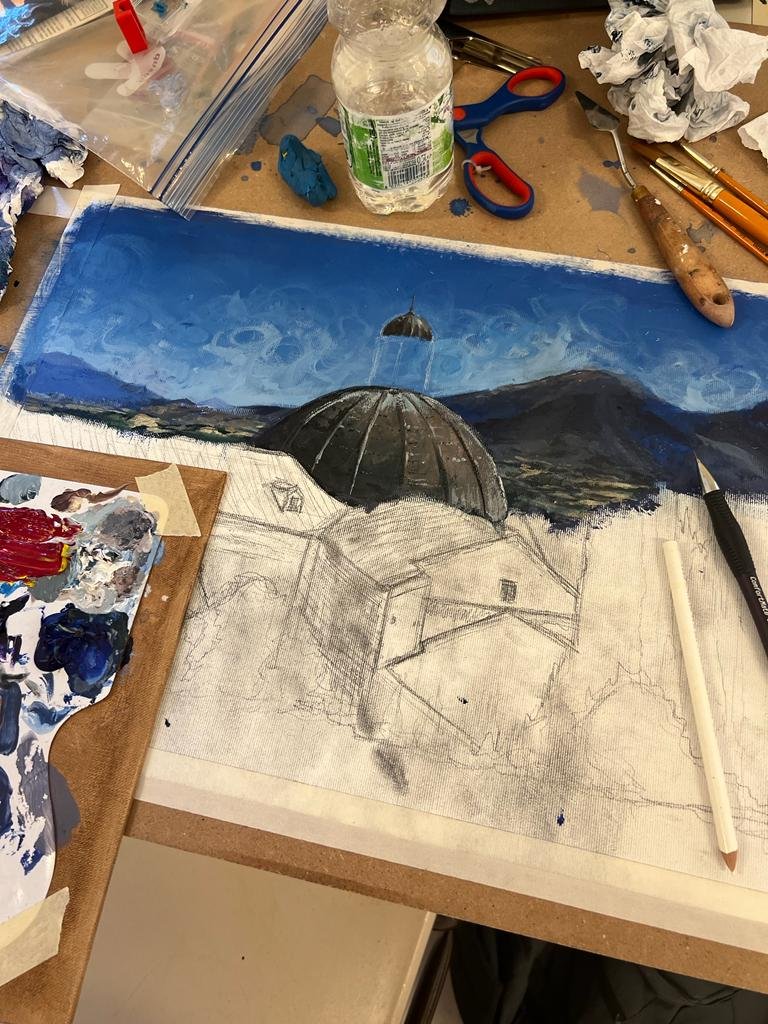




Day 3: Spello, Sunflowers, and Searching for Inspiration
Today, our visual art and photography students ventured out in search of inspiration in and around Spoleto.
Photography students had the opportunity to explore Spello, Italy—a small hill town just a half hour north of Spoleto. Spello is the location for the patron saint of photography, Saint Veronica, who formerly served as the patron saint of linen makers and linen maids. At the end of the 19th century, Saint Veronica became the patron saint of photographers, who were creating the first fixed images of reality.
“Today the photo family got to explore the beautiful Spello,” says Photography student Ellie Hayward. “The people were vibrant and the architecture was inspirational. While people-watching, we enjoyed cappuccinos, peaches, and pastries. It was a perfect morning.”
After exploring the medieval town of Spello, the photography students went out in the Umbrian countryside to visit incredibly beautiful fields of sunflowers.
Photography Intensives students experience the iconic Umbria sunflower fields
Visual Art students went into Spoleto to find inspiration for their observational acrylic drawings. “We then blocked in tones for the paintings,” says Visual Art student Lukas Asinger, “as well as planned the color scheme and style for the rest of the painting.”




Can’t wait to see what tomorrow holds!
Photography and Fine Arts Intensives Get Going
Day 2 proved to be a banner first “formal” day! Students were refreshed after a good night’s sleep and ready to explore the streets of Spoleto with their instructors and peers. After an al fresco morning breakfast at the convent, students split into small groups and tackled a scavenger hunt in the town. Using their printed maps and “cheat sheet” of Italian phrases, each group ventured forth into town to find iconic locations to help with orientation and to build confidence in preparation for their free time in the city.
Students on their Spoleto Scavenger Hunt
Students then moved into their respective discipline classes where they used the town as text and sketched and photographed architecture and people, based on what resonated with them. After lunch, students were granted time to explore the city on their own in small groups or relax during siesta. At 5:00, they started their afternoon session. Visual arts students had the privilege of sketching from two live models and exploring interpretations under time constraints. The results were amazing!




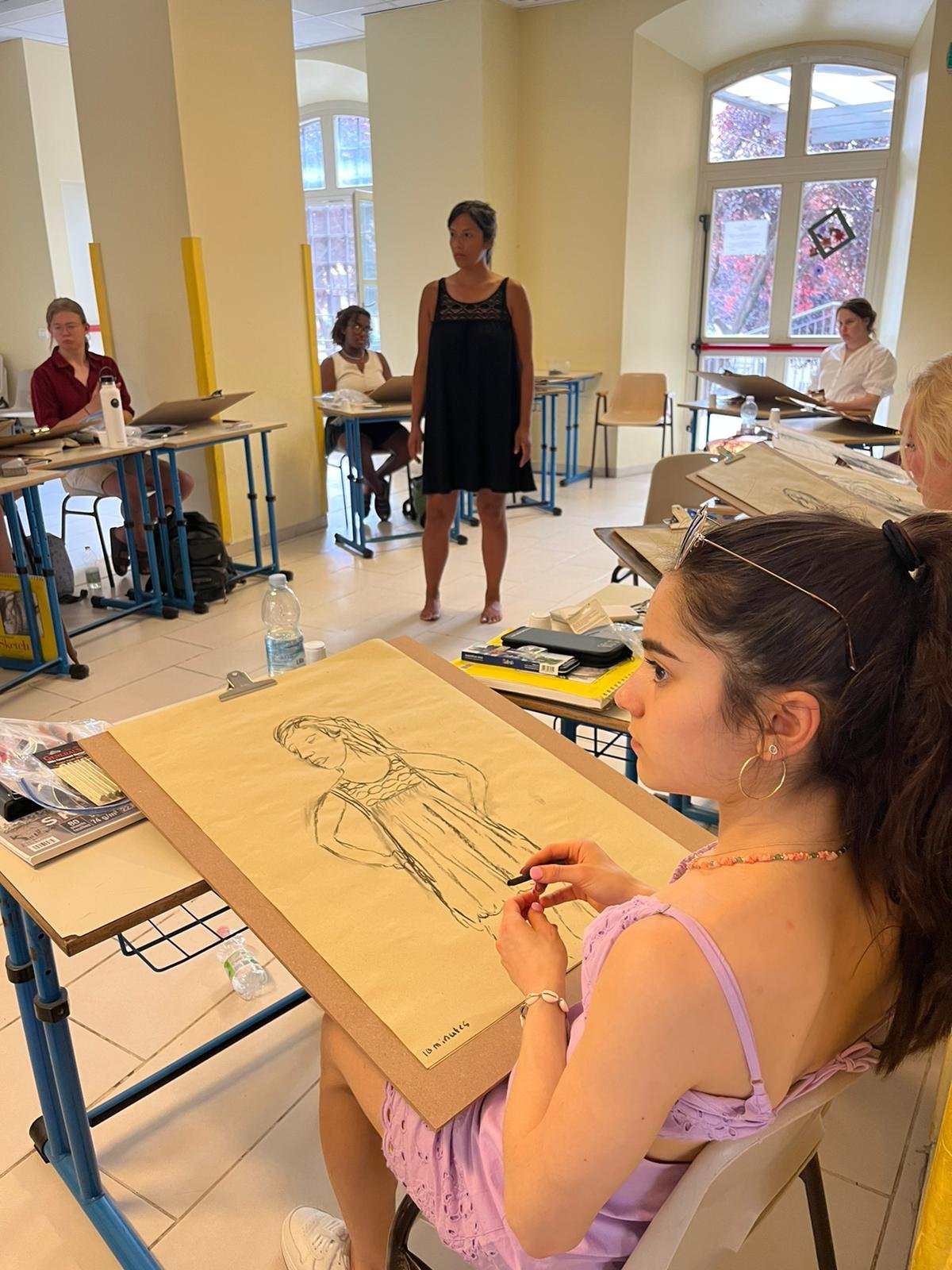


As the afternoon drew to a close, students headed to dinner and then celebrated Sophie’s birthday with signature Italian pastries provided by Mr. and Mrs. Muti. After dinner, students were granted free time in the Mercato for conversation and gelato.
Favorite Part of the Day:
“My favorite part of the day was playing WhatChaMaDrawIt after art class and seeing everyone’s silly drawings”.
– Hope Gottschling
“I loved drawing from observation in Spoleto, which is the most beautiful environment”.
– Kendra Johnson
“My favorite part of the day was wandering around and finding the Vicolo Della basilica that inspired me to capture the moment in my sketchbook….then following this by enjoying a gelato!”
– Gabriella D’Aquila
“My favorite part of the day was having the freedom to explore the city and take pictures of the aqueduct”.
– Zach Wood
Let the Student Summer Programs Begin!
After a 2 year hiatus, we are so excited to finally have our students back in Spoleto! The Summer Intensive Program began today, and we’re off to a great start. After arriving in Spoleto students enjoyed a delicious lunch at Hotel Clitunno while getting to know one another.



Once everyone settled into their rooms at the convent, Lorenzo Muti provided a walking tour of Spoleto so everyone could learn their way around town and get to know some of the magnificent points from which they can draw their creative inspiration during their stay. Tomorrow begins the Photography and Visual Arts programming and we are so excited to share what everyone is doing over the course of the next 10 days. For now, everyone is settling in for a well-earned night of sleep!






SSA's Board Journeys to Spoleto
On Monday, June 27, the Spoleto Study Abroad Board convened in Spoleto for a week of strategizing, travel, and cultural immersion. This is the first time in twenty-five years that the SSA Board was able to meet in Spoleto. The Board stayed in Palazzo Leti, a historical residence located in the heart of historic Spoleto and owned by SSA.
The first few days of this week-long Board meeting focused on strategy and discussion, but with time for wandering Spoleto and tasting delicious local foods.
The SSA Board in Palazzo Leti on Day 1
For dinner on Tuesday, the Board visited the Napolini family winery and tasted local Umbrian meats and cheeses. Wednesday saw the group heading to Montefalco for dinner, where SSA Alum and Board member Jonathan Cohen planned and hosted the evening.
Dinner in Montefalco
Come Thursday and Friday, it was time for more hands-on excursions, with truffle hunting in Fontanelle and cheese making in Monteleone. “My perspective on truffles and truffle products has completely changed,” said Board Member Tal Mangum.
(Truffle hunting and cheese making are just a couple of the things our Taste of Umbria students will have the opportunity to do during their 10-day program in a couple of weeks!)
We were thrilled to have our Board together to experience first-hand why Spoleto and SSA are so special.






Porchettiamo!
This week, roughly 40 kilometers northwest of Spoleto, the town of San Terenziano will hold its famous Porchettiamo pork festival. This annual festival celebrates the iconic street food of Central Italy: porchetta. Porchetta is a whole pig stuffed with herbs and slow-roasted in a wood-fired oven. Since Umbria is the largest pork producing region in Italy, nearly every market and festival in Central Italy will have vendors selling porchetta.
Porchetta sandwiches are probably the most popular Central Italian street food
In San Terenziano, their annual Porchettiamo will be held from June 17-19 this year. Porchettiamo means “Let’s eat pork,” so of course, the festival features porchetta in abundance, but also pork-inspired treats and unique craft beers. As the official Porchettiamo website states, “Porchettiamo is more than a festival. It is a real love declaration!”
Since eating copious amounts of pork does not appeal to everyone, there are also alternative events like a “pork-run” 10-kilometer race, concerts, food education workshops for kids, and guided tours of the medieval town of San Terenziano.
Porchetta is a whole pig stuffed with herbs and slow-roasted in a wood-fired oven
If you can’t make it to San Terenziano this weekend for Porchettiamo, don’t worry. Porchetta is popular across Italy, and Italian immigrants brought this delicious meat to the U.S. nearly 100 years ago. So, if you’re lucky, your local Italian sandwich shop might just sell porchetta.
San Pietro extra moenia
Just a quick walk from the Spoleto convent, on the southern edge of the city, lies the Church of San Pietro Extra Moenia, one of Umbria’s most important churches. Built between the 12th and 13th centuries, the church features a façade of Romanesque sculptures, including animals, figures, and reliefs. Some sources say that the church is built on the site of a temple that housed the chains used to bind St. Peter himself. Spoleto Study Abroad students often visit this church, since—along with being a beautiful example of Spoleto’s rich architectural history—it is perfectly situated south of the city to provide breathtaking views looking back up towards the aqueduct and La Rocca in Old Spoleto.
Stanley Tucci: Searching for Italy
Thanks to Italy’s diverse and historic food culture, nearly every show about travel and food makes a stop in some part of the country. One highly popular and acclaimed show that is airing right now is Stanley Tucci: Searching for Italy. Nominated for two Emmys, the series follows Italian-American actor Stanley Tucci as he travels all across Italy, exploring the culture, food, and history of each region. Tucci stops in family kitchens, local hangouts, and Michelin-starred restaurants to get the full picture of Italian cuisine.
Season 1 of this show covered Naples, the Amalfi Coast, Bologna, Milan, Tuscany, Sicily, and Rome. Season 2, which premiered on May 1, has already covered Venice, Piedmont, and Spoleto’s region of Umbria. From unique buckwheat noodles in northern Italy to San Marzano tomatoes from the volcanic soil beneath Mount Vesuvius, Searching for Italy is a foodie’s dream show, combining mouth-watering dishes with a deep exploration of the history and culture that makes Italian food so unique.
Stanley Tucci: Searching for Italy airs on CNN every Sunday, and is also available on Hulu, Sling TV, or YouTube TV.
Italian Strawberry Festivals
Did you know Italy is one of the world’s largest exporters of strawberries? All throughout the country, these delicious fruits grown in abundance during late spring and early summer. During this strawberry season, numerous cities and towns hold festivals dedicated to the fruit. Most strawberry festivals take place in late May or early June, and each is unique to its city or region.
The town of Nemi, just southeast of Rome, is considered the strawberry capital of Italy, and it holds the most famous strawberry festival: Sagra delle Fragole. This festival features numerous attractions, including tours, live music, historical costumes, and hundreds of dishes made with strawberries—tarts, jams, ice creams, even pizzas!
Strawberry pizza, with jam instead of tomato sauce
Artichoke and Orange Salad Recipe
The end of spring in Umbria is prime artichoke season, with tender varieties of this vegetable being found all over the region. Locals often thinly slice the artichokes raw and eat them in various fresh, spring salad. While we may not be able to get these exact, soft artichokes here in the U.S. right now, you can still easily make a traditional Umbrian artichoke salad with boiled artichokes. The bright color of the orange and the green of the artichoke make this dish a feast for the eyes as well as the stomach.
Ingredients:
4 small artichokes
Toasted almonds
Olive oil
2 tsp honey
1 orange, peeled and diced
Juice of 1 lemon
Parsley or mint to garnish
Dark salad greens, like arugula or spinach (optional)
Wash and trim the artichokes, then boil them until tender, roughly 16 minutes. Drain, and discard any of the tougher outer leaves of the artichokes. Roughly chop them, and then combine with the diced orange. Season with salt and pepper. Mix the honey, lemon juice, and about 2 tbsp of olive oil. Drizzle the dressing over the artichokes and oranges (and greens if using), top with toasted almonds and herbs, and enjoy!



